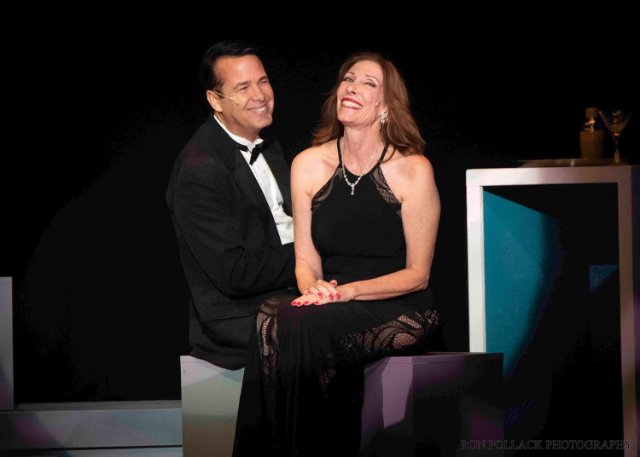Putting it Together
Sondheim Musical Revue
By: Aaron Krause - Oct 15, 2024
With skill, elegance, and humor, Pembroke Pines Theatre of the Performing Arts (PPTOPA) is paying tribute to late musical theater great Stephen Sondheim by staging the engaging musical revue, Putting it Together.
The roughly two-hour professional production, which includes an intermission, runs through Oct. 20. The venue is the Susan B. Katz Theatre in Pembroke Pines.
A fine five-member cast, while not perfect, mostly sings clearly and expressively as recorded music ably accompanies them. However, live music would probably sound richer.
The performers prove they can not only adeptly sing but act convincingly. They believably convey emotions within the songs.
Certainly, a highlight is Colleen Pagano’s flawless rendition of the patter song, “Getting Married Today” from Company. Undoubtedly, it’s one of the harder songs to sing in musical theater.
In the number, an anxious bride frantically explains that she is most certainly not getting married today. To her credit, Pagano sings the song rapidly without missing a beat. And she convinces us that she may be on the verge of a panic attack. Pagano’s rendition of “Getting Married Today” is reason enough to buy a ticket.
In addition to Pagano, who portrays Woman #1, the cast comprises James A. Skiba as Man #1, Elijah Pearson-Martinez as Man #2, Erica Kaylee Gouldthorpe as Woman #2, and Aaron Bravo as Man #3.
Behind the scenes, the production and music director is Geoffrey Mergele. The production manager is Wendy Marreo, Lisa McFadden-Murphy is the stage manager/sound operator and Michael Graham designed the lighting.
Speaking of the lighting design, it focuses the performers and sets mood. Meanwhile, the elegant costumes, such as dark tuxedos and evening gowns, befit Sondheim’s sophisticated material and this musical revue’s upscale setting. Unfortunately, the program does not list a costume designer.
The production’s shortcomings include staging issues. More specifically, performers sometimes block others who are upstage. Also, there are sound problems and the dancing at times seems tentative and awkward.
But overall, Mergele’s energetic direction elicits vibrant performances. The result is a generally triumphant afternoon or evening of live theater during which we celebrate the work of a genius. Indeed, Sondheim, whose precise, witty, sophisticated, character defining lyrics and complex, tuneful music (despite criticisms that Sondheim’s songs are not hummable) have revolutionized musical theater, has earned titles such as “The Father of the Modern Musical,”‘ “The Master,” and “The Shakespeare of Musical Theater.”
In Putting it Together, audiences experience more than 30 Sondheim songs arranged not haphazardly or chronologically, but through a dramatic framing device. Specifically, the setting is an upscale cocktail party in Manhattan. At least two couples are attending the celebration. Using Sondheim’s music and lyrics, the adults sing about topics such as art and relationships. The show gives us an idea of the depth and breadth of Sondheim’s body of work. However, the piece could use background on Sondheim for those new to the late legend’s work.
While the music and lyrics remained unchanged, the characters sing the songs outside the context of the shows in which they would normally appear.
For instance, in Sweeney Todd: The Demon Barber of Fleet Street, the titular character sings “Pretty Women” to lull Judge Turpin into a false sense of security. This leaves the judge unaware of the demon barber’s motive – deadly revenge. Contrastingly, in Putting it Together, the male characters sing the song to ponder the beauty of women. Certainly, it’s quite a different experience to hear the song sung harmlessly in a benign setting compared to the death trap that the title character has set for his victims in Sweeney Todd.
For the most part, the songs in Putting it Together fit neatly into the framework that Sondheim and co-creator Julia McKenzie created for the show. An exception is the song “Hello Little Girl” from Into the Woods.
As you may know, in that musical theater classic, a wolf sings the song to trap Little Red Ridinghood. Contrastingly, in Putting it Together, one of the male characters sings the number to seduce the other man’s wife. It just sounds strange for a grown man at an upscale cocktail party to refer to an adult woman as “little girl.” Further, it sounds odd for the married adult woman to respond, “Mother said, ‘Straight ahead, not to delay or be misled.’”
The next song, “My Husband the Pig,” is a number that follows naturally. Indeed, the seducer’s wife sings the song and it makes sense that she’d be upset with her husband.
It can be difficult to identify which performers sing which songs since the virtual program (you have to scan it to view it) does not match performers with their musical numbers. On the plus side, the program makes it clear which performers portray which characters.
Skiba, as Man #1, credibly portrays the cocktail party host as a wealthy, content individual who seems to be living the perfect life.
Sporting dark hair and a bright smile, and clad in a black tuxedo, Skiba seems to be in heaven at times. However, inwardly, the man he portrays is miserable in his marriage. And, when necessary, Skiba deftly conveys the frustration of an unhappy husband, appearing restless and irritated.
Pagano, with long brown hair, dark red lipstick, and wearing a black evening outfit and necklace as well as earrings, resembles a satisfied socialite as Woman #1. She also appears outwardly satisfied, but also believably conveys more than a hint of wanting something more.
As Man #2, Pearson-Martinez shines as a spirited young man. With long, wavy dark hair and dressed to impress, the performer imbues his character with a youthful charm and an endearing earnestness. Pearson-Martinez also shares strong chemistry with Gouldthorpe as an intense, seductive and strong Woman #2.
With dark hair and wide, piercing dark eyes, Gouldthorpe imparts an intensity that can be scary. Her character “knows how to…manipulate people as a sultry seductress,” according to an online character description of Woman #2. Certainly, Gouldthorpe lends her character determination and even a cunning air. Most certainly, she is a strong female character.
Bravo, the first actor we witness, endows the somewhat mysterious Man #3 with a showy, perhaps even devious demeanor. His persona might suggest a fast-talking con man or an attorney not unlike Billy Flynn in Chicago. Bravo certainly looks the part, wearing a black tuxedo and sporting dark hair, mustache and beard.
Bravo speaks some of the show’s first lines which elicit at least chuckles.
“Don’t cough, it tends to throw the actors off,” he sings soon after ascending the stage. “Alright, it isn’t Aristophanes, but please don’t cough.
“Don’t say what to every line you think you haven’t got. And if you’re in a snit because you’ve missed the plot (of which I must admit there’s not an awful lot) still don’t say, ‘What.’”
“If you see flaws, please, don’t drop your jaws, please, no loud guffaws please, when things don’t go as planned. During a pause, please lots of applause, please. If we don’t get a hand, you’ll have to stand for one that’s canned.”
Putting it Together is not the best Sondheim revue; that distinction goes to Sondheim on Sondheim. The latter is an insightful, humorous and touching plunge into Sondheim — the man, his music, his method and his background.
Specifically, as the title suggests, Sondheim himself (1930-2021) provides commentary and anecdotes about his life and songs, before and in between musical numbers. Of course, it’s all taped. As a result, we gain a deeper understanding of, among other things, what he wrote, why he wrote it and the challenges he encountered along the way.
While Putting it Together might be a poor man’s Sondheim on Sondheim, the former celebrates art – and that’s something we must prize…especially in 2024, with censorship so widespread.


